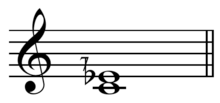Septimal minor third
| Inverse | Septimal major sixth |
|---|---|
| Name | |
| Other names | Subminor third |
| Abbreviation | s3, sm3 |
| Size | |
| Semitones | 2 2⁄3 |
| Interval class | ~2½ |
| Just interval | 7:6[1] |
| Cents | |
| Equal temperament | 300 |
| 24 equal temperament | 250 |
| Just intonation | 267 |

In music, the septimal minor third ![]() play , also called the subminor third (e.g., by Helmholtz[2][3]), is the musical interval exactly or approximately equal to a 7/6 ratio of frequencies.[4] In terms of cents, it is 267 cents, a quartertone of size 36/35 flatter than a just minor third of 6/5. In 24-tone equal temperament five quarter tones approximate the septimal minor third at 250 cents (
play , also called the subminor third (e.g., by Helmholtz[2][3]), is the musical interval exactly or approximately equal to a 7/6 ratio of frequencies.[4] In terms of cents, it is 267 cents, a quartertone of size 36/35 flatter than a just minor third of 6/5. In 24-tone equal temperament five quarter tones approximate the septimal minor third at 250 cents (![]() Play ).
Play ).
The septimal minor third may be derived in the harmonic series from the seventh harmonic, and as such is in inharmonic ratios with all notes in the regular 12TET scale, with the exception of the fundamental and the octave.[5] It has a darker but generally pleasing character when compared to the 6/5 third. A triad formed by using it in place of the minor third is called a septimal minor or subminor triad ![]() play .
play .
In the meantone era the interval made its appearance as the alternative minor third in remote keys, under the name augmented second. Tunings of the meantone fifth in the neighborhood of quarter-comma meantone will give three septimal minor thirds among the twelve minor thirds of the tuning; since the wolf fifth appears with an ordinary minor third, this entails there are three septimal minor triads, eight ordinary minor triads and one triad containing the wolf fifth arising from an ordinary minor third followed by a septimal major third.
Composer Ben Johnston uses a small "7" as an accidental to indicate a note is lowered 49 cents, or an upside down seven ("ㄥ") to indicate a note is raised 49 cents.[6]
The position of this note also appears on the scale of the Moodswinger. Yuri Landman indicated the harmonic positions of his instrument in a color dotted series. The septimal minor third position is cyan blue as well as the other knotted positions of the seventh harmonic (5/7, 4/7, 3/7, 2/7 and 1/7 of the string length of the open string).[7]
In equal temperament and non-Western scales
Twelve-tone equal temperament (12-TET), as commonly used in Western music, does not provide a good approximation for this interval, and quarter tones (24-TET) do not match it well either. 19-TET, 22-TET, 31-TET, 41-TET, 53-TET, and 72-TET each offer successively better matches (measured in cents difference) to this interval.
Several non-Western and just intonation tunings, such as the 43-tone scale developed by Harry Partch, do feature the (exact) septimal minor third.
Listening
 |
Septimal Minor Third (just intonation, 7:6 ratio), sawtooth wave
The file plays A440, followed by 513.333 Hz, followed by both tones together. |
| Problems playing this file? See media help. | |
Because of its position in the harmonic series, the sixth harmonic (frequency ratio 6:1) being a perfect fifth and two octaves above the root, the septimal minor third implies a difference tone a perfect fifth below the lower note in the interval. Depending on the timbre of the pitches, humans sometimes perceive this root pitch even if it is not played. The phenomenon of hearing this root pitch is evident in the following sound file, which uses a pure sine wave. For comparison, the root pitch is played after the interval has been played.
 |
Septimal Minor Third (just intonation, 7:6 ratio), sine wave
The file plays A880, followed by 1026.67 Hz, followed by both tones together, followed by the implied root frequency of 586.67 Hz, a fifth below the A. |
| Problems playing this file? See media help. | |
References
- ↑ Haluška, Ján (2003). The Mathematical Theory of Tone Systems, p.xxiii. ISBN 0-8247-4714-3. Septimal minor third.
- ↑ Hermann L. F Von Helmholtz (2007). On the Sensations of Tone, p.195. ISBN 1-60206-639-6.
- ↑ Royal Society (Great Britain) (1880, digitized Feb 26, 2008). Proceedings of the Royal Society of London, Volume 30, p.531. Harvard University.
- ↑ Partch, Harry (1979). Genesis of a Music, p.68. ISBN 0-306-80106-X.
- ↑ Leta E. Miller, Fredric Lieberman (2006). Lou Harrison, p.72. ISBN 0-252-03120-2. "Among the most striking intervals are...the narrow 7:6 subminor third...The seventh harmonic...was problematic in all Western tuning systems. The interval it forms with the sixth harmonic [7:6 subminor third] is smaller than a minor third but larger than a major second. To cite a specific example: the seventh harmonic of C lies partway between A and B-flat. Sounding with the sixth harmonic (G), it forms a 7:6 subminor third of 267 cents--33 cents smaller than the equal-tempered minor third, itself 16 cents smaller than the pure 6:5 minor third. This 7:6 interval is thus nearly a quarter tone smaller than the pure minor third (33 + 16 = 49 cents)."
- ↑ Douglas Keislar; Easley Blackwood; John Eaton; Lou Harrison; Ben Johnston; Joel Mandelbaum; William Schottstaedt. p.193. "Six American Composers on Nonstandard Tunnings", Perspectives of New Music, Vol. 29, No. 1. (Winter, 1991), pp. 176-211.
- ↑ "Moodswinger", oddmusic homepage
